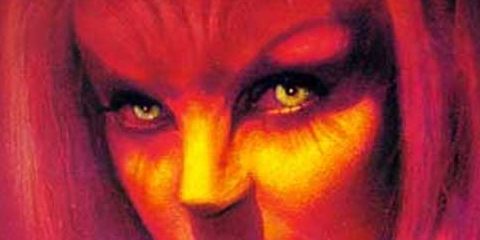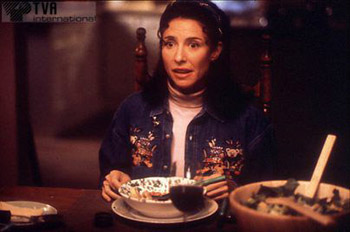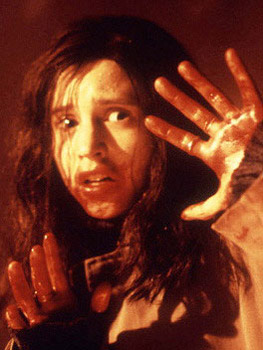Ginger Snaps: Puberty Ain't No Bed of Roses 

The full moon is rising and blood is bound to flow. A silver bullet won’t slow it down. Not even a super plus Tampax with gentle glide is going to stop it up. Ginger Snaps is a mad, biting, clever blend of coming of age story and classic werewolf horror film, perfect for a new breed of female horror fans and their (reluctant?) male counterparts. What could be a more apt way to address the change from girl to woman—through that age of unholy terror known as the teenage years—than the werewolf? Growing up is hard. Growing up as girl is especially difficult. Coming to terms with bodily changes, hair growing where there was none, alterations of body shape, and, of course, menstruation—blood, cramps, bloating, and especially the mood changes. Some sections of the feminist movement would have us all celebrating this change from girl to woman, but let’s face facts. Menstruation ain’t no bed of roses. It is full of thorns, like the one in the classic werewolf’s paw.
Ginger Snaps understands that even the better parts of becoming a grown-up can have their Jekyll and Hyde aspects. Freedom comes with responsibility, changes come with awkwardness, and new attention has positive and negative effects. All the rules and expectations that you had of life change so suddenly—you can feel your head spinning. Add to the physical and menstrual problems the fact that the timing for these physical problems is shitty. For most girls puberty comes right in the middle of the worst years for social issues. Girls and boys are both at their meanest at the most unstable and insecure moments of their lives. This is heightened by the sexual changes. Suddenly boys figure out that you are attractive and a source of pleasure and entertainment. For girls these years become a competition for attention and popularity. Even if you “win the contest,” there are so many complications. With sexual awakening comes the fears of sexuality—pregnancy and STDs—coupled with the emotional and social fears of being labeled, discarded, and/or used. Being sexually active often ends in cruel attacks on your character. You’re either the virginal Madonna or the usable and disposable whore. Either way you’re screwed. It’s about time that girls bite back. In Ginger Snaps, they do.
For Brigitte and Ginger Fitzgerald, life as a girl has never has been sugar and spice and everything nice. Growing up in suburbia has left them with a dark and bitter wit, a shared preoccupation with death (think Harold of Harold and Maude), a dedication to living on the outskirts of society and renouncing society, and a bond so close that they share every morbid experience together. They live closely bound by a sisterly pact: “Out by sixteen or dead and the same, together forever.” Their favorite activity involves the staging of elaborate photographs of their own gruesome deaths. These they share with the world as part of a school slide show project—which, not so surprisingly, gets them sent to the guidance councilor’s office, a place to which they are clearly not strangers. They are the quintessential misunderstood outsider teens.
 Who can blame them for that kind of hard-edged daydreaming when they live in the ’burbs, where everyone tries to push anything bad under the rug and anything out of the ordinary out of sight? These two are certainly not ordinary. From day one they are the target of the jeers and cruelty of their peers and the shock and outrage of the adults that should serve as their mentors. Given their preoccupation with the darker side of life, it’s not surprising that they don’t get along with the other people in town, but it seems that this doesn’t matter to them. They exist in a world of their own, separate from everyone else, and no one can separate the two. They are bound by the pact.
Who can blame them for that kind of hard-edged daydreaming when they live in the ’burbs, where everyone tries to push anything bad under the rug and anything out of the ordinary out of sight? These two are certainly not ordinary. From day one they are the target of the jeers and cruelty of their peers and the shock and outrage of the adults that should serve as their mentors. Given their preoccupation with the darker side of life, it’s not surprising that they don’t get along with the other people in town, but it seems that this doesn’t matter to them. They exist in a world of their own, separate from everyone else, and no one can separate the two. They are bound by the pact.
Everything changes at the onset of Ginger’s first period. The two sisters decide to leave the house one night, despite their parent’s warnings. There have been brutal killings of the local dogs and everyone fears that there is a dangerous wild animal on the loose. The audience is left shaking their heads, knowing they should’ve heeded their parent’s advice. (Every horror film has to have that moment where the audience knows that the main characters are stupidly walking right into danger.) Attracted by the smell of Ginger’s blood, the werewolf attacks her. The girls escape when the animal is hit by a van.
Strange things begin to happen to Ginger. The brilliance of this film is that these changes mirror the changes that normally occur during puberty. It seems fitting that Ginger, who is so dedicated to being abnormal, would pass through puberty as a werewolf. She blossoms overnight from a strange outcast to a sexy, powerful predator. Just like real life, this first taste of power doesn’t contain a full dose of confidence. Throughout the film, Ginger actually remains the sister with the lower self-confidence, far more susceptible to her need for attention and acceptance from others to feed her ego. She begins to give in to the peer pressure that she previously ignored entirely. She starts smoking marijuana, playing with the attentions of boys, and having unprotected sex. The film does a twist on STDs: Ginger passes the werewolf disease to her partner through unsafe sex. For her boyfriend, the “disease” first manifests as bleeding from the penis (a deliciously ironic twist). After the usual locker-room boasting, the other boys notice him bleeding and jokingly ask him, “Did she give you the rag, too?”
 This film has many little humorous moments, adding to the film without ever detracting from the horror. Just like real life, this film is alternately funny, terrifying, and sad. If you pay close attention, five minutes don’t go by without some pun that connects puberty and the horror genre. Just think of all the horror terms used to describe the events and emotions so tied to those teen years: a girl with her period has “the curse,” jealousy is the “green-eyed monster;” a guy that “deflowers” girls is called a “cherry-hound;” a sexual person is an “animal;” and that great insult “stick to your own species.” The writers must have had a great time.
This film has many little humorous moments, adding to the film without ever detracting from the horror. Just like real life, this film is alternately funny, terrifying, and sad. If you pay close attention, five minutes don’t go by without some pun that connects puberty and the horror genre. Just think of all the horror terms used to describe the events and emotions so tied to those teen years: a girl with her period has “the curse,” jealousy is the “green-eyed monster;” a guy that “deflowers” girls is called a “cherry-hound;” a sexual person is an “animal;” and that great insult “stick to your own species.” The writers must have had a great time.
Some of the funniest moments involve the Fitzgerald sisters’ totally clueless, perky but well-meaning mother (Mimi Rogers). Mom belongs to the clan of formerly feminist suburban mothers who cling to the last remnants of their rebellious political days by celebrating their daughters’ periods. (I say this with love. My mother wanted to throw me a party when I got my first period. The film reminds them—and us—not to take ourselves so seriously.) Best moment with mother: Brigitte keeps her mother from discovering a dead body in the freezer by saying: “What do boys want?” The ploy works like magic, although Brigitte has to sit through “the talk” in order to distract her mother from the corpse.
This film deals strongly with the fight to distinguish and separate the victim from the disease. It also deals with the fight against time to find a cure. Along with the help of Sam, the local drug dealer, Brigitte tries to find a cure for Ginger’s werewolf disease. (She also serves somewhat as Ginger’s enabler too, by covering up for her, which is another part of the complexity of the film and its relationships.) Sam and Brigitte attempt to demystify werewolfism. Using mythology and ancient medical practices as a guide, they search for something that will cure, but not kill a werewolf. Brigitte’s first attempt at curing Ginger, a silver piercing, a variation on the silver bullet and the belief that pure metals clear the system, is a failure. However, they finally find the cure in monkshood, a plant used in holistic medicine and a close and less deadly relative of wolfsbane. Unfortunately, although they possess the means, it is not enough.
The emotional kicker of this film is Brigitte’s mental and emotional struggle. Ginger’s transformation—into a woman and a werewolf—is a great loss to Brigitte. For the first time in their lives, they aren’t sharing their experience. In the beginning, Ginger considers Brigitte’s suspicions that she might be changing as evidence of “the green-eyed monster.” When Brigitte bitterly denies any desire to be doing the same things Ginger is doing, Ginger teases her: “Oh Poor B., I’m growing up and you’re not!”
As the film goes on, you see that Ginger is just as hurt as Brigitte by the growing distance between them. But it is Ginger who is really the jealous one; she can’t handle the thought of not being the most important person in Brigitte’s life. Brigitte spends more and more time with Sam—albeit to save Ginger’s life—and Ginger becomes bitter and defensive. Near the end of the film, Ginger tries to reconnect with her sister, trying to convince Brigitte to join her by becoming a werewolf too. When she refuses, Ginger retaliates by trying to seduce Sam. When Sam turns her down, she attacks him. Despite it all, Brigitte makes one last move to save her sister. She cuts her hand and grabs Ginger’s cut hand, effectively infecting herself with the werewolf disease, and screams, “You wrecked everything for me that isn’t about you—now I am you!”
 The most intense scene is the last one. Brigitte faces Ginger, now a fully changed werewolf, after she has attacked Sam, Brigitte’s only other friend and possible love interest. Brigitte tries to convince Ginger not to kill Sam by showing that she is a werewolf. Brigitte begins to eat Sam’s blood, but can’t go through with it, so Ginger kills him and turns on Brigitte. Brigitte accidentally stabs Ginger with a knife, while trying to protect herself, and the film ends with Brigitte holding the werewolf body of her sister as she dies. It’s one of the saddest moments I’ve ever seen in a film. There’s so much in it: the strength of the bond between these two sisters; the changes in their relationship; the inability to share everything with someone you’ve always done everything with; and the suicide pact that they had shared for so long. Brigitte finally revokes the pact, saying, “I’m not dying in this room with you! I’m not dying!”
The most intense scene is the last one. Brigitte faces Ginger, now a fully changed werewolf, after she has attacked Sam, Brigitte’s only other friend and possible love interest. Brigitte tries to convince Ginger not to kill Sam by showing that she is a werewolf. Brigitte begins to eat Sam’s blood, but can’t go through with it, so Ginger kills him and turns on Brigitte. Brigitte accidentally stabs Ginger with a knife, while trying to protect herself, and the film ends with Brigitte holding the werewolf body of her sister as she dies. It’s one of the saddest moments I’ve ever seen in a film. There’s so much in it: the strength of the bond between these two sisters; the changes in their relationship; the inability to share everything with someone you’ve always done everything with; and the suicide pact that they had shared for so long. Brigitte finally revokes the pact, saying, “I’m not dying in this room with you! I’m not dying!”
If you haven’t guessed already, this is not your usual horror film. It defies so many conventions, while still delivering shivers and jumps. It isn’t a film about the fear of the other, nor is it exactly the fear of the external unknown. This is a film about the horrible changes that can occur within us. It’s about that terrible time when you grow apart from things and people that you loved as a child, about fears that are a real and painful part of life. The drama of this film is not about blood and guts—it’s about dealing with change and struggling to stop the changes before time runs out. In Ginger Snaps, as in other werewolf films, it’s the loss of humanity, not the loss of life, that drives the horror.
